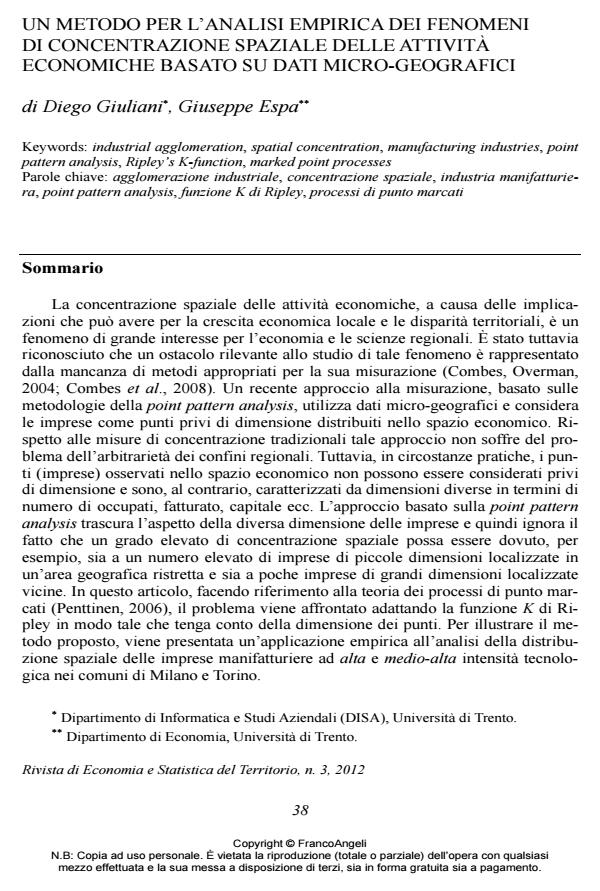A microgeographic-based method for the empirical analysis of spatial clusters of firms
Journal title RIVISTA DI ECONOMIA E STATISTICA DEL TERRITORIO
Author/s Diego Giuliani, Giuseppe Espa
Publishing Year 2012 Issue 2012/3
Language Italian Pages 21 P. 38-58 File size 802 KB
DOI 10.3280/REST2012-003003
DOI is like a bar code for intellectual property: to have more infomation
click here
Below, you can see the article first page
If you want to buy this article in PDF format, you can do it, following the instructions to buy download credits

FrancoAngeli is member of Publishers International Linking Association, Inc (PILA), a not-for-profit association which run the CrossRef service enabling links to and from online scholarly content.
The spatial concentration of firms has long been a central issue in economics both under the theoretical and the applied point of view due mainly to the important policy implications. A recent approach to its measurement based on the point pattern analysis methodologies, which does not suffer from the problem of the arbitrariness of the regional boundaries, makes use of micro-geographic data and looks at the firms as if they were dimensionless points distributed in the economic space. However in practical circumstances the points (firms) observed in the economic space are far from being dimensionless and are conversely characterized by different dimension in terms of the number of employees, the product, the capital and so on. The point pattern analysis methodologies based approach disregards the aspect of the different firm dimension and ignores the fact that a high degree of spatial concentration may result from both the case of many small firms clustering in definite portions of space and from only few large firms clustering together. The present paper aims at tackling this problem. Methods and Results The method we propose consists on adapting the K-function (Ripley, 1977) to account for the point dimension using the framework of marked point process theory (Penttinen, 2006). This adaptation allows us to develop a statistical test for the presence of absolute spatial concentration of firms while controlling for their sizes. We present an empirical application to the spatial distribution of high-tech industries in Milan and Turin (Italy), which confirms the utility of the proposed method. Conclusion We show that the developed approach is a proper method to detect for the presence of spatial clustering phenomena in an empirical context where the firm’s dimension matters.
Keywords: Industrial agglomeration, spatial concentration, manufacturing industries, point pattern analysis, Ripley’s K-function, marked point processes
Jel codes: C21, D92, L60, O18, R12
Diego Giuliani, Giuseppe Espa, Un metodo per l’analisi empirica dei fenomeni di concentrazione spaziale delle attività economiche basato su dati micro-geografici in "RIVISTA DI ECONOMIA E STATISTICA DEL TERRITORIO" 3/2012, pp 38-58, DOI: 10.3280/REST2012-003003